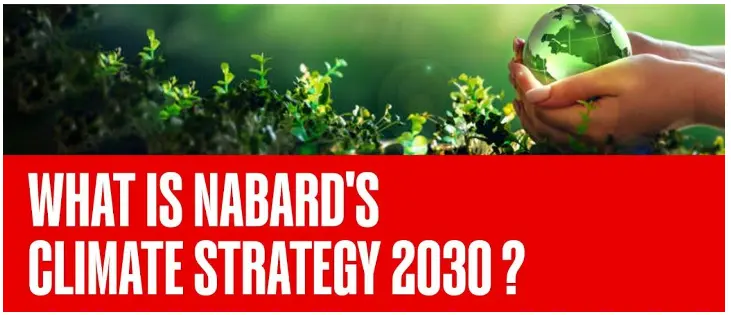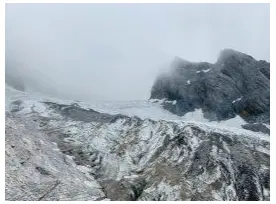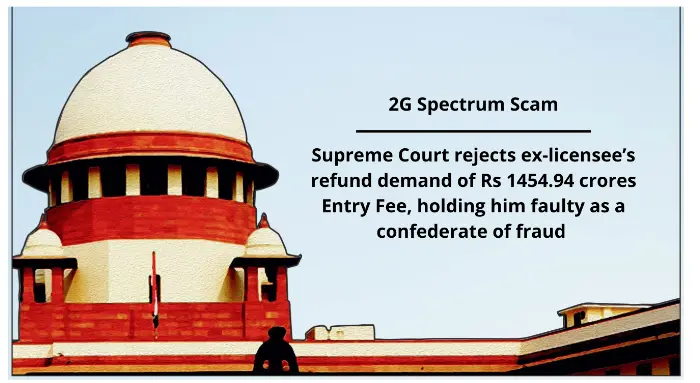Wednesday, 1st May 2024
Solar Radiation Decline in India
In News: As worries regarding climate change intensify, the significance of renewable energy sources such as solar power becomes more apparent.
Key Highlights of the Study
- Aerosol Load
- Increased aerosol load from various sources like carbon emissions and dust contributes to reduced solar radiation.
- Aerosols can absorb and deflect sunlight away from the ground, affecting solar panel efficiency.
- Decline in Solar Photovoltaic (SPV) Potential
- Analysis indicates a widespread decline in SPV potential across monitored stations in cities like Ahmedabad, Chennai, and Mumbai.
- This decline is observed even in regions with large solar parks like Gujarat and Rajasthan.
- Global Solar Radiation (GR) over India
- GR varies across India, with maximum in northwest and inland peninsular India and minimum in extreme north and northeast.
- Reduction in GR attributed to increased atmospheric turbidity and cloudiness, particularly during the monsoon season.
- Diffuse Radiation (DR)
- Diffuse radiation, scattered by atmospheric particles, has significantly increased in more than 50% of stations, especially in northwest and some parts of peninsular India.
Implications for India's Solar Power Goals
- Current Scenario
- India aims to source 500 GW of electricity from non-fossil fuel sources by 2030, with solar power contributing a significant portion.
- Despite ambitious targets, annual solar power additions have struggled to meet expectations.
- Challenges
- Hindrances to solar power development include land acquisition, grid integration issues, slow growth of rooftop solar, and limited storage technology.
- Government Initiatives Related to Solar Energy
- Production Linked Incentive Scheme (PLI)
- Solar Park Scheme
- PM-KUSUM
- Rooftop Solar Programme
- International Solar Alliance (ISA)
Way Forward
- Analyse Aerosol Types
- Identify aerosol sources contributing to solar radiation decline, such as black carbon from vehicles and industrial dust.
- Enact Targeted Policies
- Implement policies to address specific aerosol sources and partner with local authorities to tackle pollution hotspots.
- Promote Bifacial Solar Panels
- Focus on promoting bifacial solar panels to capture sunlight from both sides and incentivize domestic manufacturing to reduce reliance on imports.
- Partner with International Organizations
- Collaborate with international organizations like IRENA to share data and best practices for mitigating air pollution's impact on solar radiation.
- Deploy AI-powered Cleaning Systems
- Develop AI-powered robotic systems for automated cleaning of solar panels to optimize efficiency, particularly in arid regions.
- Mandate Rooftop Solar Panels
- Enact building codes mandating pre-installation of rooftop solar panels on all new commercial and government buildings to increase adoption and reduce reliance on traditional grid power.
|
UPSC Previous Year Questions Prelims (2019) Q. In the context of which of the following do some scientists suggest the use of cirrus cloud thinning technique and the injection of sulphate aerosol into stratosphere? (a) Creating the artificial rains in some regions (b) Reducing the frequency and intensity of tropical cyclones (c) Reducing the adverse effects of solar wind on the Earth (d) Reducing the global warming Ans: (d) Prelims (2016) Q. Consider the following statements:
Which of the statements given above is/are correct? (a) 1 only (b) 2 only (c) Both 1 and 2 (d) Neither 1 nor 2 Ans: (a) Mains (2020) Q. India has immense potential of solar energy though there are regional variations in its developments. Elaborate. |
Source: TH
Iran-Israel Conflict
In News: The ongoing conflict between Israel and Iran has generated a state of unrest, impacting the security of the significant Indian diaspora residing in the Gulf region.

Reasons for the Iran-Israel Conflict:
- Historical Context
- The relationship between Iran and Israel has been tumultuous since the Iranian Revolution of 1979.
- Iran's transformation into an Islamic Republic led to open hostility towards Israel, unlike the previous alliance under the Shah.
- Religious and Ideological Differences
- Iran is an Islamic republic governed by Shia Islam, while Israel is predominantly Jewish.
- These differences contribute to mutual suspicion and animosity between the two nations.
- Israeli-Palestinian Conflict
- Iran supports Palestinian causes and militant groups like Hamas and Hezbollah, considered terrorist organizations by Israel.
- Iran's backing of these groups and calls for Israel's destruction heighten tensions.
- Geopolitical Rivalry
- Iran and Israel compete for influence in the Middle East, leading to conflicting interests in regional conflicts.
- Their support for opposing factions in conflicts like Syria and Yemen exacerbates tensions.
- Nuclear Program
- Israel views Iran's nuclear program with concern, fearing it could pose an existential threat.
- Israel opposes the Iran nuclear deal and has taken actions to disrupt Iran's nuclear activities.
- Proxy Conflicts
- Both countries engage in proxy conflicts through support for opposing factions in neighboring countries.
- Iran's support for Hezbollah in Lebanon and Shia militias in Iraq is perceived as a threat by Israel.
- Regional Power Dynamics
- The competition between Iran and Israel shapes the balance of power in the Middle East.
- This competition contributes to a cycle of tensions and conflicts in the region.
Implications of the Iran-Israel Conflict on India
- Economic Implications
- Conflict could disrupt oil supply from the region, impacting global oil prices and India's energy costs.
- India's oil imports through the strategic Strait of Hormuz may face supply shortages, affecting economic growth.
- Diaspora
- The safety of the Indian diaspora in West Asia, particularly the Persian Gulf, could be jeopardized by regional tensions.
- Evacuation efforts may be necessary to ensure their safety during periods of heightened conflict.
- Connectivity
- Tensions could affect India's strategic connectivity interests, including projects like the Chabahar port in Iran.
- Shipping disruptions in the region could lead to delays and increased costs in global trade.
- Diplomatic Challenges
- India's relations with both Iran and Israel pose diplomatic challenges during conflicts between the two nations.
- Maintaining neutrality while safeguarding national interests becomes more challenging in such situations.
|
UPSC Previous Year Questions Prelims (2015) Q. Which one of the following countries of South-West Asia does not open out to the Mediterranean Sea? (a) Syria (b) Jordan (c) Lebanon (d) Israel Ans: (b) Prelims (2018) Q. The term “two-state solution” is sometimes mentioned in the news in the context of the affairs of (a) China (b) Israel (c) Iraq (d) Yemen Ans: (b) Mains (2018) Q. “India’s relations with Israel have, of late, acquired a depth and diversity, which cannot be rolled back.” Discuss. |
Source: TH
Unclassed Forests
In News: In response to a PIL challenging the Forest (Conservation) Act Amendment (FCAA) 2023, the Ministry of Environment, Forests and Climate Change (MoEFCC) uploaded State Expert Committee (SEC) reports on its website as per a Supreme Court order. The petition raised concerns about the status of unclassed forests, which were to be identified by these reports.
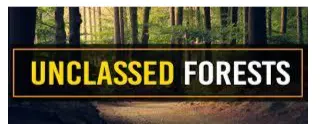
Understanding Unclassed Forests
- Definition and Legal Protection
- Unclassed or deemed forests encompass areas that may belong to various entities, including government bodies, communities, or private owners, but lack official notification as forests. They received legal safeguarding following the T.N. Godavarman Thirumalpad case of 1996.
- Forest (Conservation) Act 1980
- The Forest (Conservation) Act 1980 (FCAA) stipulates regulations concerning unclassed forests, requiring Central Government approval for any diversion of such lands for non-forest purposes. This Act broadens the scope of protected areas but excludes specific land categories from its purview.
- FCAA Stipulations
- The FCAA mandates prior permission from the Central Government for activities like dereservation of reserved forests, non-forest land use, and tree clearance for reafforestation. However, it excludes certain land categories, potentially conflicting with the 1996 SC judgment on preventing deforestation.
Challenges in Identifying Unclassed Forests
- Despite the requirement for State Expert Committees (SECs) to identify unclassed forests, several states have not constituted SECs or provided reliable data on such forests.
- Inconsistencies in data sources and lack of geographic location specifics pose challenges in accurately identifying and protecting these forests.
Consequences and Recommendations
- The absence of proper identification and protection of unclassed forests raises concerns about potential ecological damage and non-compliance with forest policies.
- There is a need for accountability among responsible parties and proactive measures by the national government to rectify this issue in line with the 1996 judgment and forest conservation goals.
Source: TH
G7 eyes possible end date for coal-fired power plants
In News: G7 energy ministers recently discussed phasing out coal-fired power plants during their meeting in Turin, Italy.

About G7
- Origin
- The G7 originated in response to the oil shocks and financial crisis of 1973.
- In 1975, the heads of the world's six leading industrial nations held a meeting to address the situation.
- Initially, the group consisted of the US, UK, France, Germany (West), Japan, and Italy.
- Canada joined the group in 1976, leading to the formation of the G7.
- Current Members
- The current members of the G7 are the US, UK, Canada, France, Germany, Italy, and Japan.
- These countries represent the most developed and advanced economies globally.
- The European Union is also represented within the G7 framework.
- Purpose of G7
- The G7 serves as a platform for determining the course of multilateral discourse.
- It aims to shape political responses to global challenges, providing a forum for discussing and coordinating solutions to major issues.
- Areas of focus include trade, security, economics, and climate change.
Coal-fired Power Plants
- About
- Coal-fired power plants generate electricity by burning coal to produce steam.
- The steam drives a turbine, which spins a generator to create electricity.
- Afterward, the steam is cooled, condensed back into water, and recycled in the process.
- Emissions
- Emissions from coal-fired power plants include sulphur dioxide (SO2), nitrogen oxides (NOx), particulates, carbon dioxide (CO2), mercury, and other heavy metals.
- These emissions contribute to environmental pollution and health issues.
- Coal-fired Plants in India
- Currently, thermal power from coal accounts for almost 60% of India's total installed power generation capacity.
- Coal-fired power generation supplies over 75% of the electricity to the grid.
- India heavily relies on coal due to its abundance and affordability.
- Potential
- India's coal reserves are expected to last around 100 years.
- Projections suggest an increase in coal-based power generation capacity to 250 gigawatts by 2030.
- However, there are plans to decrease coal's share in the electricity generation mix to 50% by 2030.
- Reasons Against Coal-fired Plants
- Coal-fired power plants contribute to climate change and environmental pollution.
- Phasing out coal-fired plants is crucial for limiting global warming and reducing pollutants.
- Phasing out Coal-fired Plants and G7
- Ministers from the G7 are considering a common target to shut down coal-fired power plants.
- This discussion occurred during a meeting in Turin, Italy, led by Italy, the current G7 presidency.
- The G7's commitment is significant given its economic influence and greenhouse gas emissions.
Source: TH
About TacticAI
In News: TacticAI underwent development and evaluation through a multi-year research partnership between Google's DeepMind and experts from Liverpool Football Club.
Exploring TacticAI: Enhancing Football Tactics with AI
- TacticAI is an artificial intelligence system designed to offer tactical insights, particularly focusing on corner kicks in football, through predictive and generative AI algorithms.
- Football team managers can utilize TacticAI as an assistant tool for refining their tactical strategies during matches.
- Developed by Google's DeepMind, TacticAI integrates both predictive and generative components. This allows coaches to efficiently explore various player setups for each corner kick scenario and select those with the highest predicted success rates.
- Corner kicks are strategically significant moments in football matches, as they offer a frozen moment in the game, starting from a consistent position at the corner of the pitch. This provides players with an immediate opportunity to score.
- Strategies for corner kicks are typically pre-decided by coaches well in advance of match day, ensuring clarity and avoiding confusion when executed on the field.
- In football, a corner kick is awarded when the ball crosses the goal line after being last touched by a player from the defending team.
Source: IE
IMF's Stand-By Arrangement
In News: As part of the bailout package backed by the IMF's Stand-By Arrangement (SBA), the International Monetary Fund has authorized an immediate disbursement of USD 1.1 billion to Pakistan.
The IMF's Stand-By Arrangement: Key Aspects and IMF Overview
- The Stand-By Arrangement (SBA) is designed to offer short-term financial aid to countries grappling with balance of payments challenges. It has historically been the preferred lending mechanism for both advanced and emerging market economies.
- Eligibility for the SBA extends to all member nations facing actual or potential external financing difficulties. While it is predominantly utilized by advanced and emerging market economies, low-income countries occasionally access the SBA alongside the Standby Credit Facility (SCF).
- Conditionality is a central feature of the SBA, requiring recipient countries to address the underlying issues that prompted their request for financial support. Disbursements are contingent upon meeting specified quantitative performance criteria. Additionally, progress in implementing essential structural reforms is evaluated comprehensively, including through predefined benchmarks.
- The duration of assistance under the SBA is flexible, typically spanning a period of 12 to 24 months, with a maximum extension of 36 months.
- Key aspects of the International Monetary Fund (IMF) include its role in fostering economic growth and employment through temporary financial aid to facilitate balance of payments adjustments and technical assistance.
- Established in 1944 at the Bretton Woods Conference, the IMF's primary objective was to reconstruct the international monetary system.
- Noteworthy publications issued by the IMF include the World Economic Outlook and the Global Financial Stability Report.
- The IMF's headquarters are located in Washington, DC, USA.
Source: TH
Global Leaders Group on Antimicrobial Resistance
In News: In Barcelona, Spain, the European Society for Clinical Microbiology and Infectious Diseases and the Global Leaders Group (GLG) on Antimicrobial Resistance (AMR) collaboratively hosted a prestigious event titled 'Forging Partnerships Between Science and Policy.'
The Global Leaders Group on Antimicrobial Resistance: Key Aspects and Background
- The Global Leaders Group on Antimicrobial Resistance comprises world leaders and experts from various sectors collaborating to expedite political action on antimicrobial resistance (AMR).
- Functioning autonomously, the group plays a vital global advisory and advocacy role, aiming to sustain urgency, garner public support, maintain political momentum, and enhance the visibility of the AMR challenge on the global health and development agenda.
- Established in November 2020 at the recommendation of the Interagency Coordination Group (IACG) on Antimicrobial Resistance, the Global Leaders Group on AMR seeks to bolster worldwide political momentum and leadership on the issue.
- The inaugural meeting of the Group convened in January 2021, marking the initiation of collaborative efforts towards addressing AMR challenges.
- The Quadripartite Joint Secretariat (QJS) on Antimicrobial Resistance, jointly operated by the Food and Agriculture Organization of the United Nations (FAO), the United Nations Environment Programme (UNEP), and the World Organisation for Animal Health (OIE), provides secretariat support for the Group.
Understanding Antimicrobial Resistance (AMR)
- Antimicrobial resistance (AMR) refers to the capability of bacteria and other microbes to withstand the effects of drugs intended to inhibit or kill them.
- Often termed 'superbugs,' these microbes are accountable for drug-resistant infections that pose significant challenges in treatment.
- Causes of AMR
- While AMR is a natural occurrence, the primary cause of resistance to antimicrobials stems from the extensive use of antimicrobial drugs.
- Elevated usage of antimicrobial drugs in humans, animals, and plants contributes to a troubling escalation in drug resistance, rendering infections increasingly difficult to manage.
Source: DTE
Paradox of Savings
In News: The paradox of savings contends that an increase in individuals' savings can paradoxically lead to a notable decline in overall savings and investment.
Understanding the Paradox of Savings: Theory, Origins, and Criticisms
- The paradox of savings, also referred to as the paradox of thrift, posits that an increase in individual savings rates may paradoxically lead to a decrease rather than an increase in overall savings within an economy.
- Contrary to the conventional belief that higher individual savings rates translate into higher aggregate savings for the economy, this theory suggests that excessive saving at the individual level can have detrimental effects on the broader economic landscape.
- While saving is generally viewed as beneficial for individual households, it is argued that it may not necessarily contribute positively to the wider economy.
- This concept is rooted in the under-consumption theories of the business cycle, which attribute economic downturns to weak consumption and high levels of savings.
- The theory gained prominence through the work of British economist John Maynard Keynes, notably outlined in his seminal 1936 book, "The General Theory of Employment, Interest, and Money."
- Keynesian economists advocate against higher savings rates, contending that stimulating consumer spending is crucial for economic growth. They argue that savings are ultimately invested to produce goods and services for consumption, and a lack of consumer spending can dampen investment incentives.
- Critics of the paradox of savings argue against the notion that increased saving is detrimental to the economy. They assert that a decrease in consumer spending does not necessarily result in reduced investment.
- According to critics, unspent money typically channels into savings, which in turn fuels investment opportunities. This increased savings pool enables banks to lend more, driving down interest rates and stimulating borrowing and spending.
- Thus, the criticism challenges the idea that higher savings rates hinder economic growth, suggesting instead that increased saving can facilitate investment and contribute positively to economic expansion.
Source: TH
Salmonella
In News: Since October 2023, the United States has allegedly rejected nearly one-third of shipments from Mahashian Di Hatti Pvt Ltd (MDH) due to concerns over salmonella contamination.
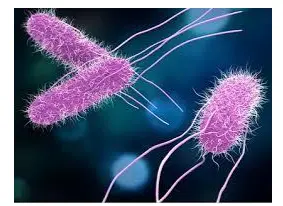
Understanding Salmonella: Causes, Transmission, and Risks
- Salmonella comprises a group of bacteria known for causing gastrointestinal illness and fever, a condition referred to as salmonellosis.
- Naturally inhabiting the intestines of animals, Salmonella can be present in their feces, posing a risk of transmission to humans.
- Transmission to humans occurs when they come into contact with Salmonella-infected animals or contaminated items within their environment.
- Salmonella is characterized by its widespread presence and resilience, capable of surviving for several weeks in dry environments and several months in water.
- Risks associated with Salmonella infection include symptoms such as diarrhea, fever, and stomach cramps.
- Certain demographics, including children under 5 years old, adults over 65 years old, and individuals with weakened immune systems, are particularly vulnerable to experiencing severe illness requiring medical intervention or hospitalization as a result of Salmonella infection.
Source: ET
Great Rift Valley
In News: Heavy rains and floods wreaked havoc in Kenya's Rift Valley region, resulting in a tragic incident where a dam burst its banks near a town, claiming the lives of at least 42 individuals.
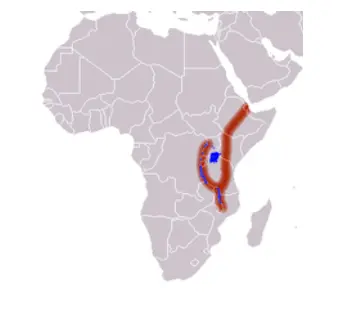
Exploring the Great Rift Valley: Features, Formation, and Significance
- The Great Rift Valley stands as one of the most expansive rifts on Earth's surface, spanning a distance of approximately 4,000 miles (6,400 kilometers) across East Africa.
- Stretching from Jordan in southwestern Asia to the central coast of Mozambique in the Indian Ocean, it traverses numerous countries including Eritrea, Djibouti, Ethiopia, Kenya, Tanzania, Uganda, Rwanda, Burundi, the Democratic Republic of the Congo (DRC), Malawi, Zambia, and Mozambique.
- This geological wonder is part of the broader East African Rift System (EARS).
Formation
- The Great Rift Valley owes its existence to the convergence of three tectonic plates, originating approximately 40 million years ago when these plates split, initiating the formation of the East African Rift.
- With an average width ranging from 30 to 40 miles (48 to 64 kilometers), the valley widens significantly to nearly 300 miles (480 kilometers) in the Danakil Desert of northeastern Africa.
- Its steep walls tower above the valley floor, reaching heights of about 3,000 feet (900 meters) and cliffs soaring up to 9,000 feet (2,700 meters) in some regions.
- Characterized by geological activity, the area boasts features such as volcanoes, hot springs, geysers, and frequent seismic events.
- Along its expanse, a chain of approximately thirty lakes is found, including the renowned Great Lakes of Africa, such as Lake Tanganyika, the world's second-deepest lake, and Lake Victoria, the second-largest freshwater lake by surface area globally.
- The Great Rift Valley is home to several of Africa's highest peaks, including Mount Kilimanjaro, Mount Kenya, and Mount Margherita, situated in ranges that flank the valley.
Understanding Rift Valleys
- A rift valley is a lowland region formed by the movement of Earth's tectonic plates, where they diverge or rift apart.
- These valleys can be found both on land and beneath the ocean, where they originate from the process of seafloor spreading.
- Rift valleys are distinct from river valleys and glacial valleys as they are shaped primarily by tectonic forces rather than erosion processes.
Source: News18
Court’s nudge on hospital charges, a reform opportunity
In News: A recent article delves into the escalating healthcare costs in India and underscores the need for healthcare financing reforms that go beyond simple price regulations to achieve affordable hospital care.
Clinical Establishments (Central Government) Rules, 2012
- About
- The Clinical Establishments (Central Government) Rules, 2012 were formulated under the Clinical Establishments (Registration and Regulation) Act, 2010, granting authority to the Central Government.
- Appointment of Secretary of the National Council by the Central Government
- The Ministry of Health and Family Welfare designates a Joint Secretary as the ex-officio Secretary of the National Council for clinical establishments, ensuring coordination and oversight.
- National Council and its Sub-Committees
- The National Council categorizes clinical establishments and forms sub-committees with diverse representation to oversee specific tasks, ensuring a balanced approach.
- Minimum Standards for Medical Diagnostic Laboratories
- Clinical establishments must adhere to specified standards for diagnostic services, ensuring quality and reliability for patients.
- Other Conditions for Registration and Continuation of Clinical Establishments
- Establishments are mandated to display service rates, comply with treatment guidelines, and maintain electronic medical records, enhancing transparency and patient care.
Reasons for Rising Healthcare Costs in India
- Unregulated and Profit-Oriented Health Sector
- Private providers prioritize profits, leading to price inefficiencies and overprovision of care, necessitating regulatory oversight.
- High Out-of-Pocket Expenditures (OOPEs)
- Over half of healthcare costs are borne by individuals, highlighting the need for comprehensive financing reforms.
- Weak Implementation of Laws
- Enforcement challenges hinder effective regulation, impacting care quality and affordability.
- Issues in Capping Medical Devices
- Price caps on medical devices face implementation challenges, failing to address stakeholders' incentives.
- Corporatization of Healthcare
- Shift towards profit-driven healthcare compromises affordability, necessitating regulatory measures.
- Inadequate Investments in Public Hospitals
- Underinvestment in public healthcare leads to overcrowding and infrastructure deficits, exacerbating costs.
- Inadequate Political Priority
- Healthcare lacks political attention, hindering reforms essential for accessibility and affordability.
Preventive Measures to Control Healthcare Costs
- Formulating Standard Treatment Guidelines (STGs)
- STGs can standardize care practices, ensuring efficient resource allocation and cost containment.
- Comprehensive Health Financing Reform Strategy
- A holistic reform strategy is needed to align incentives and address systemic inefficiencies.
- Following Models of Tamil Nadu and Rajasthan
- Procurement of generics and insurance schemes can reduce costs and improve access to medicines.
- Maintaining Transparency in Rate Standardization
- Transparent rate displays and adherence to government-prescribed rates promote accountability and affordability.
- Preventing Irrational Healthcare Interventions
- Standard protocols can curb unnecessary procedures, improving care quality and reducing costs.
- Implementing Patients’ Rights
- Protecting patients' rights ensures transparency and accountability in care delivery.
- Controlling Commercialization of Colleges
- Regulating medical colleges' fees and expanding public education can mitigate commercialization in medical education.
- Reforming National Medical Commission and NEET
- Reforms in medical education and entrance exams can ensure equitable access and quality standards.
Government Initiatives Related to Healthcare
- National Health Mission
- Ayushman Bharat
- Pradhan Mantri Jan Arogya Yojana (AB-PMJAY)
- National Medical Commission
- PM National Dialysis Programme
- Janani Shishu Suraksha Karyakram (JSSK)
- Rashtriya Bal Swasthya Karyakram (RBSK)
- Increased Allocation for Health in Budget 2021
- PM Atmanirbhar Swasth Bharat Scheme
- National Digital Health Mission
- National Medical Commission (NMC) Act, 2019
- Pradhan Mantri Bhartiya Janaushadhi Pariyojan
Conclusion
Addressing rising healthcare costs requires comprehensive reforms, including standardization, financing strategies, and regulatory measures, to ensure affordability and accessibility for all.
|
UPSC Previous Year Questions Prelims (2017) Q. Which of the following are the objectives of ‘National Nutrition Mission’?
Select the correct answer using the code given below: (a) 1 and 2 only (b) 1, 2 and 3 only (c) 1, 2 and 4 only (d) 3 and 4 only Ans: (a) Mains (2021) Q. “Besides being a moral imperative of a Welfare State, primary health structure is a necessary precondition for sustainable development.” Analyse. |
Source: TH
Share the article
Edukemy’s Current Affairs Quiz is published with multiple choice questions for UPSC exams
MCQ
Get Latest Updates on Offers, Event dates, and free Mentorship sessions.

Get in touch with our Expert Academic Counsellors 👋
Frequently Asked Questions
UPSC Daily Current Affairs focuses on learning current events on a daily basis. An aspirant needs to study regular and updated information about current events, news, and relevant topics that are important for UPSC aspirants. It covers national and international affairs, government policies, socio-economic issues, science and technology advancements, and more.
UPSC Daily Current Affairs provides aspirants with a concise and comprehensive overview of the latest happenings and developments across various fields. It helps aspirants stay updated with current affairs and provides them with valuable insights and analysis, which are essential for answering questions in the UPSC examinations. It enhances their knowledge, analytical skills, and ability to connect current affairs with the UPSC syllabus.
UPSC Daily Current Affairs covers a wide range of topics, including politics, economics, science and technology, environment, social issues, governance, international relations, and more. It offers news summaries, in-depth analyses, editorials, opinion pieces, and relevant study materials. It also provides practice questions and quizzes to help aspirants test their understanding of current affairs.
Edukemy's UPSC Daily Current Affairs can be accessed through:
- UPSC Daily Current Affairs can be accessed through Current Affairs tab at the top of the Main Page of Edukemy.
- Edukemy Mobile app: The Daily Current Affairs can also be access through Edukemy Mobile App.
- Social media: Follow Edukemy’s official social media accounts or pages that provide UPSC Daily Current Affairs updates, including Facebook, Twitter, or Telegram channels.

